|
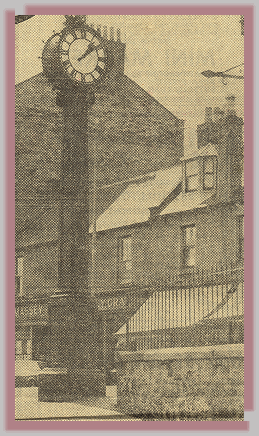
The Hilltown Clock
I could see it from our bedroom window.
My granny swore it never told the right time, but we checked it daily.
My teenage daughter, Adriana, said to me
the other night, "Mom, it’s hard to imagine you as a little girl,
growing up, and maybe having thoughts like I do."
I felt ancient. So, we sat down and I
retraced my steps in these pictures of the Hilltown Clock and Hill Street
School. I think of my feet running up and down the Hilltown and along
Strathmartine road with messages for my granny to Massey’s and Grey’s,
over to Johnny Batchie (real name Bachelor) my granny’s bookie with her
lines, back and forth between our house and the school next door and know,
that with this book for my family, those days will never be lost.

Our School at the Top o’ the Hill
If you look to the upper left corner, just
as the school fence ends, you’ll see the side of a tenement building.
That’s 7 Hill Street. That’s where my mother was born, and I was born
in the very same bed she was born in. I used to visit with the Bobbies in
the police box just right there in the front of the picture, and make
phone calls from the phone box right next to it. Saturday and Sunday
nights the Coffee Stall would park right there on the corner where the
cars are, and I’d look out my window and watch the grown ups not acting
like grown ups after a night on the town. There was some grand singing,
some great fights, and a very interesting parade of people talking and
flirting their way home with a cup of tea, or instant coffee, or a hot
dog, or a lettuce and tomato sandwich to see them home.
Now that I’m an adult, a mother and a
grandmother, and a working social worker I understand how important safety
and security is to a child. I felt safe in our house. I felt loved by my
family. I knew my mother would do everything she could to give me the
things I needed because I saw her work hard, scrubbing floors as a
cleaning woman, and working in the jute mi.ll and the battery factory. I
knew my granny would physically protect me against all dangers because she’s
the one who said, "Gi’e him to the weemin’" when a young
child ages with me in our neighborhood was raped and strangled and the
perpetrator was caught by the little girl’s father. And I knew not only
my grandmother had expectations of, not for me, but that these
expectations were also those of her father and her grandmother and her
grandmother’s grandmother. That connection with the past is what my
granny used to give me a future and perhaps this is a similar effort I’m
putting forth with these memories for my family after me.
Famous McIntosh’s
 The
Encyclopedia Britannica we have in our lobby here in Phoenix, Arizona,
doesn’t have too many McIntosh’s in it – Charles Mackintosh who
invented the raincoat of the same name is mentioned; and so is Charles
Rennie Mackintosh the Glaswegian architect and designer. This rose is a
picture of the Glasgow Rose Bookmark my daughter Xochitl, gave me as a
gift from The Museum Store – the gift card The
Encyclopedia Britannica we have in our lobby here in Phoenix, Arizona,
doesn’t have too many McIntosh’s in it – Charles Mackintosh who
invented the raincoat of the same name is mentioned; and so is Charles
Rennie Mackintosh the Glaswegian architect and designer. This rose is a
picture of the Glasgow Rose Bookmark my daughter Xochitl, gave me as a
gift from The Museum Store – the gift card
states "the briar rose is the motif
most often associated with the Glasgow School whose artists advocated
design based on extreme simplicity of form. This version of the rose is
taken from a mother-of-pearl inlay on a cabinet designed by George Logan
for Wylie and Lochhead, the principal manufacturer of artistic furniture
in turn of the century Scotland."
Not so famous McIntosh’s, but they’re
our McIntosh’s
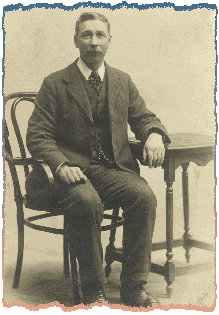 This
is my great grandfather who was a carter, driving those beautiful
Clydesdales in Dundee, and who raised champion Airedales just as this
terrier breed was being developed in the north of England and Scotland. My
favourite stories from my mother and granny about his dogs are two about
"Jeemy", (probably spelled "Jimmy" but "Jeemy"
in Dundonese) whose champion name was Welshot Warrior and one about a
stray he gave a home to called "Ironsides." Jeemy was a very
protective dog who would let people in the house, but wouldn’t let them
leave without his master saying it was all right for the visitors to go.
My granny told the story of being in the pub and someone saying
"These airedales aren’t worth anything." Apparently, my great
grandfather put a pound note on the counter and told the other man,
"If you can take it you can have it." The man tried, but my
great grandfather kept his pound note. This
is my great grandfather who was a carter, driving those beautiful
Clydesdales in Dundee, and who raised champion Airedales just as this
terrier breed was being developed in the north of England and Scotland. My
favourite stories from my mother and granny about his dogs are two about
"Jeemy", (probably spelled "Jimmy" but "Jeemy"
in Dundonese) whose champion name was Welshot Warrior and one about a
stray he gave a home to called "Ironsides." Jeemy was a very
protective dog who would let people in the house, but wouldn’t let them
leave without his master saying it was all right for the visitors to go.
My granny told the story of being in the pub and someone saying
"These airedales aren’t worth anything." Apparently, my great
grandfather put a pound note on the counter and told the other man,
"If you can take it you can have it." The man tried, but my
great grandfather kept his pound note.
My mother’s favourite story is about the
time as a wee bairn about four years old she took some unwound knitting
wool, wrapped it around Jeemy’s collar and took him for a walk out of
the tenement. Seems my granny and great grandfather were hunting high and
low for her when, lo and behold, she and Jeemy came strolling round the
corner, Jeemy still wearing the leash of "raveled wool." And the
ending of the story always was – because you know in story telling
traditions and people the stories get told over and over again –
"And you know how that kind of wool isna’ up to much."
As far as Ironsides is concerned,
apparently this was a wee stray that my great grandfather took pity on. I
always thought of this dog as something like Tramp in the Walt Disney
cartoon. Seems this was a surviving street dog who never quite lost his
habit of running into the butcher shop on the Hilltown and stealing a nice
cut of meat or two. Seems "the butcher was aye throwin’ his wechts
at Ironside and telling my granddad he’d get that dog yet, but it never
stopped that dog from stealing from the butcher."
Charlotte Beat McIntosh
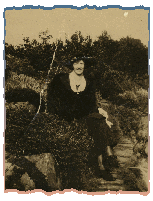

These pictures are taken in
Carmarthenshire , Wales where my grandfather was from. I think the lady on
the right is "Auntie Maud" my grandfather’s sister.

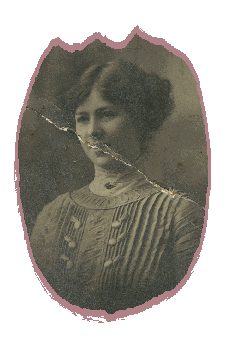
My grandmother and mother on holiday in
Wales between the Wars.
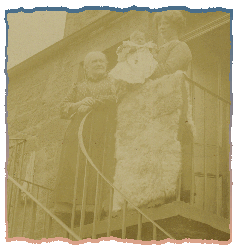 Jessie
Hackett Beat McIntosh on our "plettie" at 7 Hill Street. If you
look closely you can see the "pullashie" where, even in my day
at this address, we hung our clothes out to dry – can you see the towel
hanging out? I played on these stairs all through my childhood. Jessie
Hackett Beat McIntosh on our "plettie" at 7 Hill Street. If you
look closely you can see the "pullashie" where, even in my day
at this address, we hung our clothes out to dry – can you see the towel
hanging out? I played on these stairs all through my childhood.
The inscription on the back of the
photograph is "To Granny from Baby Johnston."
Fashion Plates – My Brother and Me
Growing Up
(Starting in the Backies!)
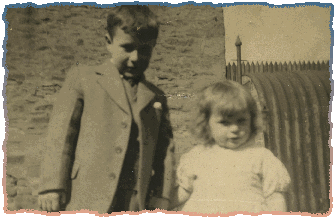
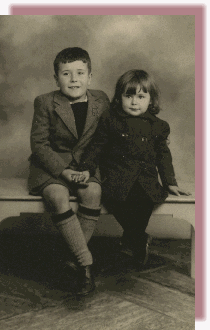 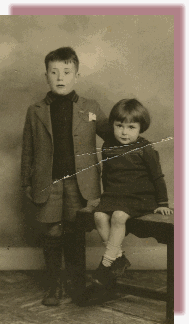
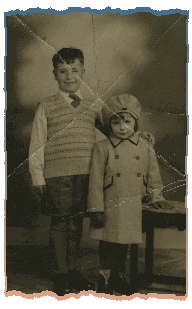
This one is dated "Nov 1950"
– I would have been about 4and my brother a;most 8.
My Brother
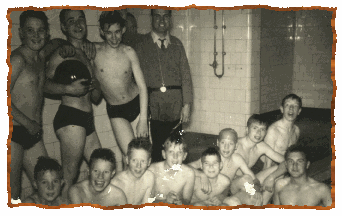
My brother, Victor – or Jerome Victor
Eric Alvoet as his Sunday name – holding the polo ball with Willie Hosie’s
Young Swimmers’ Athletic Union (YSAU) team at the Lochee Baths

My brother sitting in some poor German
Empress’s lap when he was in the Army Cadets and at Camp with the Army
around 1960 when he was about 17 or so.
One More Look at #7
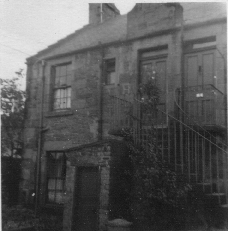
Our
living room – truly was since we ate and cooked and washed and lived
there and my granny slept on a couch bed there – is the window on the
upper left and the wee window is our toilet. There’s the front door with
the big brass lion door knocker that my Granny polished every day and the
equally polished brass letter box I remember getting into a lot of trouble
for pushing worms through and calling to my Granny there was a
"surprise comin’ through the letter box." Mrs Flett from
England and her husband and son Peter and daughter Patricia lived next
door, and if you look really closely you can almost see the apple tree
that never went beyond a sapling that I planted from a seed when I was in
primary school. The shed beside the dustbin was once the communal toilet
until we all went indoors, and the window below us Mrs. McNab’s house
– this was the woman my Granny loathed and she once grabbed in the close
in the dark – by the throat, mind you – and told her never to bother
her or our family again, and Mrs. McNab never did. Mrs. McNab loved
listening to the radio and I remember every Sunday she would play
"Desert Island Discs" loud enough that we could hear the ten
pieces of music the celebrity castaways wanted to be on a desert island
with. And she had a record player, too – everybody in the tenement but
us had electricity, remember – and she played "Some Enchanted
Evening" so many times that I learned the words. But my favourite
memories are of the fights she had with her husband over him having a
girlfriend and my Granny and Mum would shush me so they could hear every
word of the entertainment. I can hear Mrs. McNab yelling at her husband,
clearly to this day, "You’re a merried man and she’s a merried
wumman!" And the best is my Granny telling my brother when he joined
the Boys’ Brigade that he was to learn the "drums and no’ the
pipes" because beating the drums on the big green "kist"
(chest) we had above Mrs. McNab’s bedroom would annoy her more!
Symers Street, My Last Dundee Home
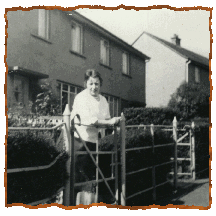
My mother at the gate at Number 54
Click
here for Dundee by Gaslight and other Pictures of Dundee
A Few Last Thoughts on "A
Hilltown Family"
I received the following
e-mail, sent by Kathleen Smart as part of my membership on ANGUS-L@rootsweb.com
in November of 1999 when there was active correspondence about the
Hilltown:
A short note on housing in
18/19th century Dundee. With apologies if I am repeating
someone else.
"The northern limits of
the medieval nucleus are to be seen – stretching north-eastwards from
the HOWFF or old burying ground, which was granted to the town council by
Mary, Queen of Scots in 1564, to Victoria Road, an open thoroughfare by
1901 which had replaced the older tortuous route through Bucklemakers Wynd.
Bucklemaker Wynd was likely
around the bottom of Hilltown where it meets Victoria Road.
Note on housing in the area of
Hilltown. Until it was sold to Dundee in 1697, Hilltown was outside the
burgh’s boundary and had itself been created a burgh of barony in 1643.
Even in the late 18th century, however, spacially it was simply
a ribbon of shops, small workshops and houses built on each side of the
main road from Dundee to inland Forfar. In some respects the area still
retained this character in 1901, with the premises of bakers, tea
merchants, fruiterers and licensed grocers figuring prominently on the
valuation rolls. However, 19th century industrial developements
in the vicinity led to its becoming, like the aforementioned Cowgate
areas, as well as the Scouringburn and Hawkhill, densely populated. (Eh
wis brot up in the Hawkie).
There were 30,000 more people
in Dundee in 1861 than in 1841, but over that period only 568 extra houses
were built.
Much of the largely Irish
immigrant population then, was packed into the existing housing stock,
typically one and two storey cottages which were sub-divided and then
frequently further sub-let, and in the attics and cellars to be found in
the numerous pends and wynds of the most dilapidated parts of the town.
The premium on space led to the erection of ‘back tenements’, three
and four story blocks, sited on the feus behind the buildings, of which
there were 582 (housing c 17,000) in Dundee in the early 20th
century, are to be seen on the map in the vicinity of Hilltown, 72 per
cent of Dundee’s families in 1901 lived in either one or two roomed
houses. (And nae watter inside and ablutions doon the backies.
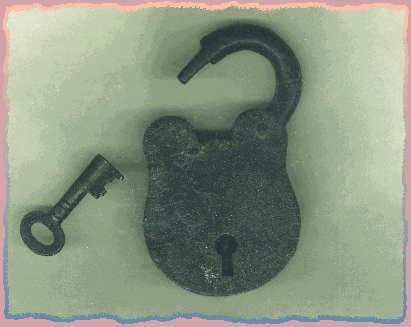
This is the padlock and key that my Granny
used, all my life if not longer, to lock the old outside toilet we used as a
shed at Hill Street and the actual shed made from an old corrugated iron air
raid shelter at Symers Street. The lock has stamped on it "SECURE 2
LEVER".
"Cuddle Doon"
My mother often talked about a
family they knew when she was a child, just across the street from us in
Hill Street, who lived in one of the two storey tenements, not the big
four or five storey directly across from us with the big pend and the
Clydesdale stables, who had a family of five or six kids. I can’t
remember their name, but my Mum said that on the lichty nichts when the
warm nights allowed open windows, she could always hear the kids in this
family calling to their parents, fighting amongst themselves, and
complaining about who was taking up the most space in their three to a bed
arrangements. When I learned this poem at Miss Angus’s elocution, we
would both be minded of those neighbours from her childhood.
The bairnies cuddle doon at
nicht
Wi’ muckle fash an’ din.
"Oh, try and sleep, ye waukrife rougues;
Yer faither’s comin’ in."
They never heed a word I speak.
I try to gi’e a froon;
But aye I hap them up, an’ cry,
"Oh, bairnies, cuddle doon."
Wee Jamie wi’ the curly
heid –
He aye sleeps next the wa’ –
Bangs up an’ cries, "I want a piece" –
The rascal starts them a’.
I rin an’ fetch them pieces, drinks –
They stop awee the soun’ –
Then draw the blankets up, an’ cry,
"Noo, bairnies, cuddle doon!"
But ere five minutes gang,
wee Rab
Cries oot, frae ‘neath the claes,
"Mither, mak’ Tam gie ower at ance,
He’s kittlin’ wi’ his taes."
The mischief’s in that Tam for tricks;
He’d bother half the toon.
But aye I hap them up, and cry,
"Oh, bairnies, cuddle doon!"
At length they hear their
father’s fit;
An’ as he steeks the door,
They turn their faces to the wa’,
While Tam pretends to snore.
"Ha’e a’ the weans beed gude?" he asks,
As he pits aff his shoon.
"The bairnies, John, are in their beds,
An’ lang since cuddled doon."
An’ just afore we bed
oorsels,
We look at oor wee lambs,
Tam has his airm roun’ wee Rab’s neck,
An’ Rab his airm roun’ Tam;s.
I lift wee Jamie up the bed,
An, as I straik each croon,
I whisper, till my heart fills up,
"Oh, bairnies, cuddle doon!"
The bairnies cuddle doon at
nicht
Wi’ mirth that’s dear to me;
But soon the big warl’s cark an’ care
Will quaiten doon their glee.
Yet, come what will to ilka ane,
May He who rules aboon
Aye whisper, though their pows be bald,
"Oh, bairnies, cuddle doon!"
This was written by a Scot
named Alexander Anderson, who died aged 64 in 1909. I think he also wrote
"The Two Angels" I have earlier in this book. He also wrote a
companion poem to "Cuddle Doon" called "Wauken Up"
that I no longer have, but hope to find on the Internet some day. |
